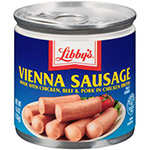
I stockpile a lot of canned goods, from tomatoes to chicken, to beans and beef. But my favorite canned goods are Libby’s chicken Vienna sausages (see picture).
So I tried to make them at home and believe it or not, they are more delicious than the ones I bought.
The ones I stock have a 3 year expiration date. I have eaten lots of things that were expired. These will still be good years after that. So in the title I mentioned a 2 years shelf life for my sausages, but it can actually be much more. We’ll find out.
Ingredients:
– 6 lbs ground pork
– 4 lbs ground beef
– 2 cups cold milk
– 1 cup flour
– ½ cup grated onion
– 3 tbsp salt
– 2 tbsp ground coriander
– 1 tbsp sugar
– 1 tbsp mace
– 1 tbsp paprika
– ½ tbsp cayenne
– 5 tbsp beetroot juice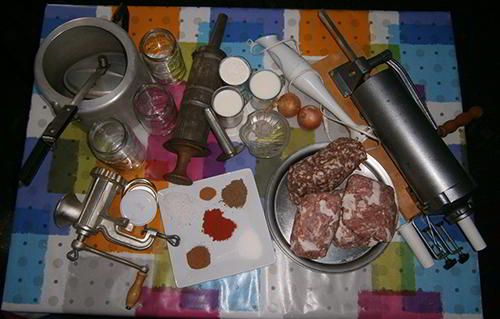
Step One: Extracting the Beetroot Juice and Grinding the Meat
Beetroot juice is used to give it the usual color of Vienna sausage that we all know.
First, grind down the beetroot; then push it through some sort of filter to get all the juices out of it. You don’t really need a lot, so it’s okay to work in smaller amounts.
After you are done with that, grab the meat and grind it down two times with a grinder to make sure that there are no large chunks.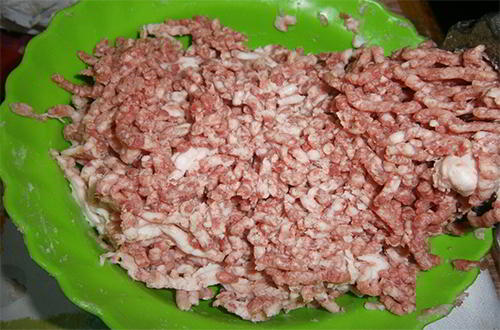
Add all of the ingredients, and grind it down four more times with a hand blender, stopping blending after 10 minutes and resting the blender for 30 minutes to cool it down.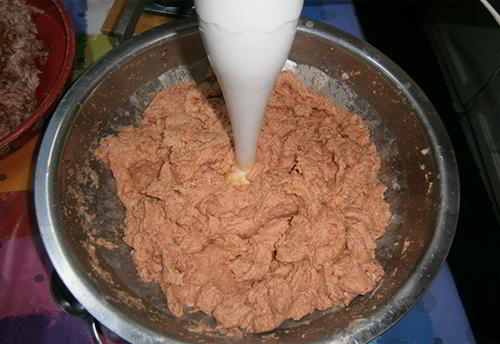
After mixing and grinding the meat, leave it in the fridge to rest for two hours.
Step Two: Making the Sausages
Vienna sausages are thin compared to normal sausages, and because of that, we need to use sheep intestine. Grab the intestine, and gently wash it out with water. Make sure both the inside and the outside are clean.
Then pull the guts onto the sausage filler gently, making sure not to puncture or rip it.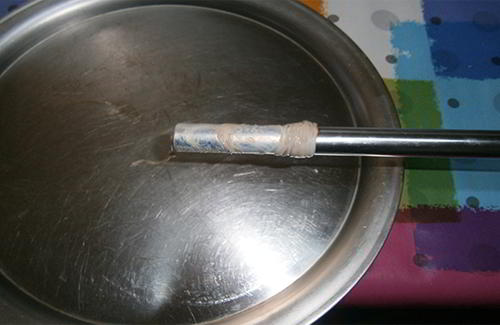
Now we have everything ready to start filling.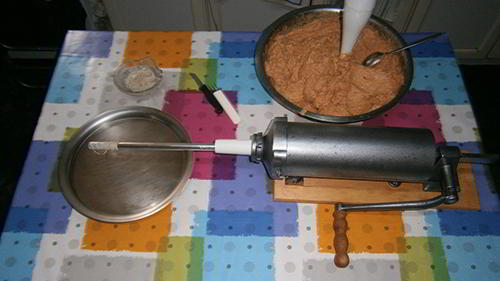
Tie a knot to the end of the gut, and slowly start filling it up with the sausage mix.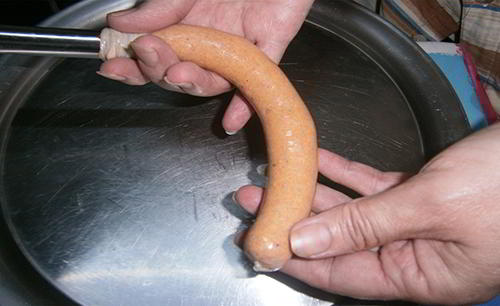
The longer you can get it, the better. Vienna sausage is usually kept long then twisted to create the smaller-sized sausages.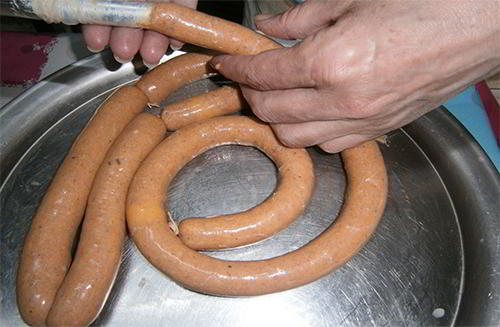
This is what I was working with. Gently pinch the sausages, pushing some of the meat away, then slowly and gently twist it once like you would twist a balloon.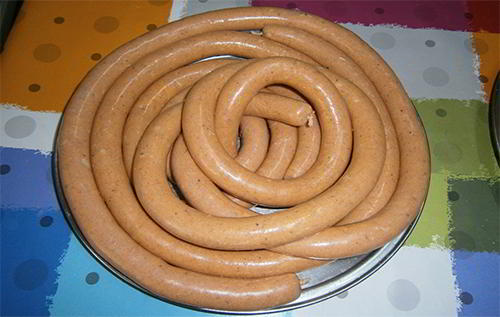
Step Three: Smoking the Sausages
First, start up your grill, and separate the charcoal into two parts with a metal container. They must be fully separate; this way you will get two fires that can keep the container heated. Fill the container with water.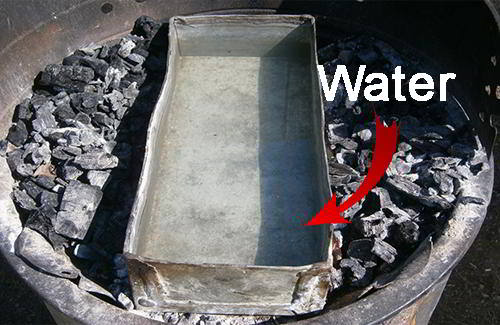
Now cover the water and leave it until the water begins to boil.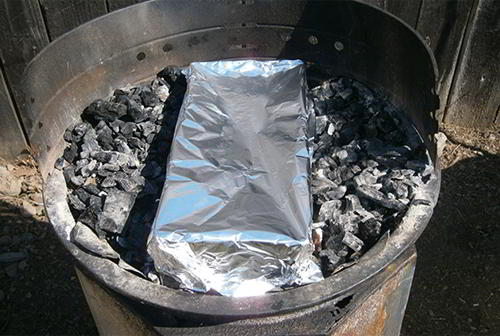
After it’s boiling, you can now grab the sausages.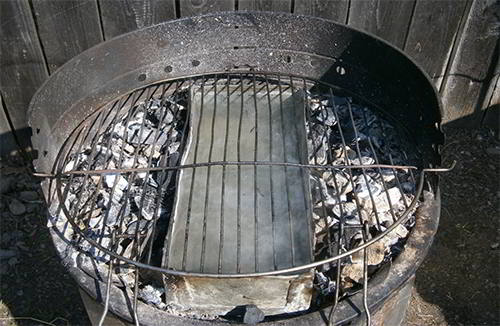
Place the sausages right on top of the boiling water on a grill. This way it will boil, and with the coal, it will gently roast.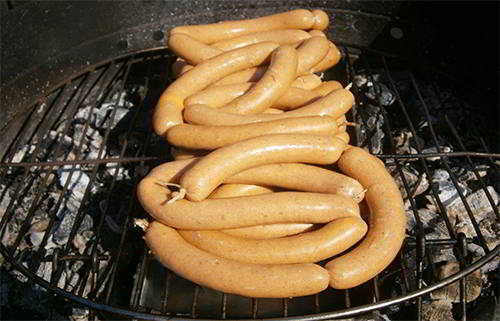
If you have an enclosed grill, the next step will be easy, but if you don’t, you need to start thinking of a way to cover it. I simply put a large pot over it.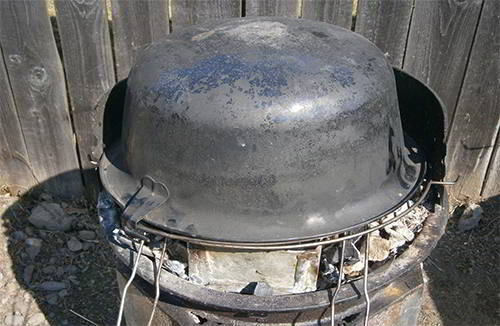
Leave it covered until the internal heat of the sausages reach 152°F. This is how mine looked after finishing. Mine took one hour to heat up.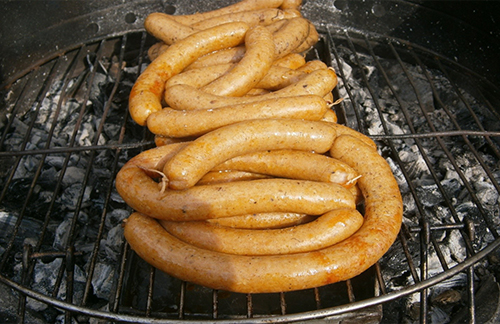
Step Four: Heat Treating the Sausages
After you are done with smoking the sausages, you need to heat treat them. First make a salt mixture with water, putting as much salt into it as you want, depending on your tastes. I used a teaspoon of salt in two cups of water.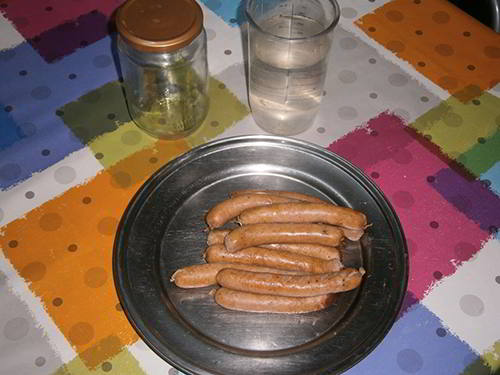
Place the sausages tightly inside a jar until it’s filled to the brim.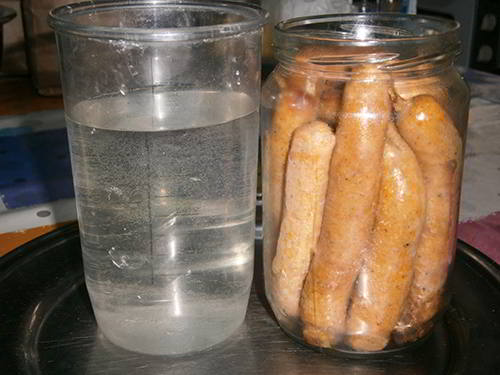
Fill it with the salt water, and seal it tightly with the cap.
Grab your pressure cooker, and place the jar inside. Fill the cooker with water until the jars are one-third covered. Don’t forget to use cold water. 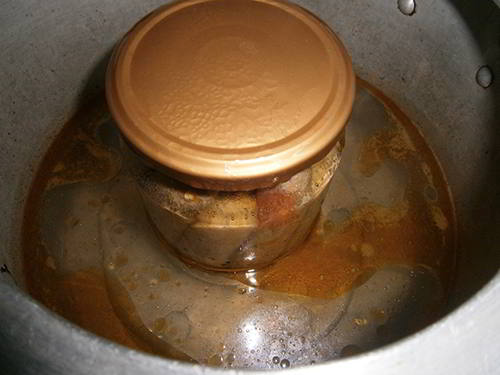 Turn on the stove, and cook it until the water starts boiling. Leave it inside for five more minutes then turn off the stove and let it slowly cool off inside the cooker.
Turn on the stove, and cook it until the water starts boiling. Leave it inside for five more minutes then turn off the stove and let it slowly cool off inside the cooker.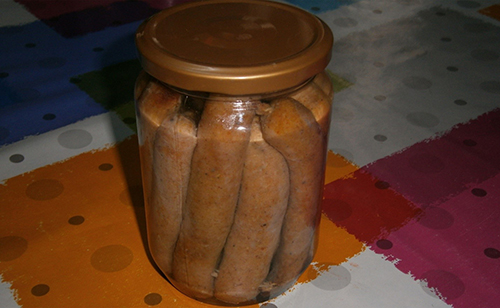
After smoking it, heat treating it, and placing it inside a cold storage room or a fridge, these sausages can last up to two years. Once you do end up opening a jar, you have 48 hours to snack on those delicious, homemade, fresh Vienna sausages, but I’m sure they won’t last for an hour.
You may also like:
 How to Build a Smokehouse In Your Backyard (with Pictures)
How to Build a Smokehouse In Your Backyard (with Pictures)
An Insanely Effective Way to Build a 5 Year Food Stockpile (video)
How To Make a Mini Root Cellar In Your Backyard In Less Than Two Hours






















How many hours are spent making these?
Wannabe; that is what I was thinking. All that work for Vienna sausages? I would rather have a recipe for ITALIAN SAUSAGE. This is the first time, I am complaining about this site’s, information. But, I guess, something is better then nothing. How about pickled eggs, that have protein , and probably easier to make. I don’t know. ☺
It is a lot of work – good stuff usually takes more work. 🙂 But, I agree somewhat. I would rather not have to do that extra step of smoking. I have canned Italian sausage before – store bought. Good to have in your stash. You can find plenty of Italian sausage making videos online. This “how to” was definitely different. Your pickled eggs peaked my interest but to us meat eaters having a good meal with meat is very satisfying and would be good for the soul in an SHTF situation.
Carol, I started to look in my files, and apparently, I have an ITALIAN sausage recipe since 2012! Dislike getting old. The eggs were just so we had, some protein, alternative. I am a big meat eater too.
Italian sausage
5-lbs coarsely ground pork
1-cup cold wine (red or white), or water
1-cup chopped fresh parsley
5-tsp salt
1-tbsp garlic powder or-4 to 5 garlic cloves, minced
1-tbsp fresh ground pepper
2 to 3-tsp cayenne *
5-tbsp fennel seed
2-tsp crushed chili peppers *
5-tbsp paprika
1-tsp anise, optional (ground)
Mix all seasoning together with 1-cup cold liquid
Mix seasonings with ground meat Stuff into hog casings. Or you can make patties, and not stuff Into casings. Reduce pepper flakes and Cheyenne.
I do not know, if these can be ‘canned’.
Yes, they can. I regularly make hot Italian sausage, and also regularly can it. Make the sausage links a wee bit longer than a wide mouth quart jar, pack in as many as you can fit, seal and pressure cooked for 90 minutes.
In fact, that’s what I had for dinner last night! 1 and 1/2 cups rice, 2 cups water, and 1 quart jar of hot Italian sausage with juice, all dumped into a rice cooker, and 25 minutes until dinner for two, and some leftover for the dogs.
me and my dogs love vienna dogs – i’m going to give it a shot i’m sure we both will enjoy it – and there will be less chemicals TOO !!! i make sausages all the time .
Excellent recipe! Thanks so much for posting it! I cannot wait to try this one!
Shabda. Let us know,if you survive this.
Hummmm!!!! I personally would NOT rely on this product being safe. A high protein (meat in this case) hot water processed without “an acid environment” is just looking for trouble – botulism poisoning-!!! This bacteria has killed a lot of folks over the years, meats, string beans, fish, etc. all protein containing, “processed” at boiling temperatures. ELEVATED PRESSURE cooking temperatures are absolutely needed with proteins or you are playing roulette with your family and your life. Even if it doesn’t kill you, you could be VERY SICK for days. Pressure processing, at the correct pressures and times for what ever altitude you are in,,,,, then this sounds GREAT,,, otherwise I would NOT DO IT AS WRITTEN.
You are absolutely correct. These sausages sound great but if you want to avoid botulism poisoning, you MUST pressure can them. A pressure canner will reach the temperature ( 240 degrees + ) that will kill the bacteria. A water bath canning procedure WILL NOT.
I believe the instructions and pictures indicate a pressure canner.
Dave,
The “pot” shown is a pressure cooker but the instructions are for a short period, hot water bath. Maybe a goof by the author, but a dangerous one. 5 minutes in the boiling water IS NOT pressure cooking. for this, 15 lbs at 45 to 60 minutes would be the more likely time/pressure instruction and then there is the need for properly dealing with the hot. pressurized pressure cooker, getting the “heat” out properly then cooling and proper/safe pressure relief. Your “understanding” of what was/is presented is EXACTLY what is the problem here. The author used a pressure cooker bottom but never did any lidded, pressurized “pressure cooking” and thus the article was very mis leading, especially for someone who has never used either a pressure cooker or water bath process. A GREAT way to get someone sick or dead.
Sorry Dave. These were the instructions: “Grab your pressure cooker, and place the jar inside. Fill the cooker with water until the jars are one-third covered. Don’t forget to use cold water. Turn on the stove, and cook it until the water starts boiling. Leave it inside for five more minutes then turn off the stove and let it slowly cool off inside the cooker.” Pressure Canners require 10 lbs of continuous pressure (or 15 based on your altitude) for 75 minutes (pints) 90 minutes for quarts.
I agree with JD and Carol. Call your local extension or university and ask for a food handling expert. They will tell you this is an unsafe way to process sausages.
This is so exciting! I form antibodies to chicken, but turkey is fine, so I can finally make these. They sound delicious! What a treat!
Question: Does anybody have any ideas about what I might substitute for the milk? Dairy is also a problem. What is the function of the milk in the recipe? If it’s just to liquefy the meat, maybe I could use hemp milk. If there is some other purpose, what might it be? Any organic chemists or food science folks out there?
I saw a YouTube video by someone who was kosher and couldn’t mix dairy and meat. He used almond milk. You might try that. There is an unsweetened version. Not sure how the sweetened version would work in the sausages.
That’s great! Thanks, Carol! I will try that!
Dried milk acts as a binder and helps retain the moisture of the meat. You can use up to 12 % (of the meat weight) without affecting the taste of the sausage. I am sure the milk in the recipe given on this site is for lubrication and getting the correct consistence of the meat mix. I ams sure you could use ice (common in commercial sausage making to keep the meat cool while it is being ground stick makes heat) and for water lubrication. You could use most any liquid, juice from cooking the meat, vegetable juice, wine, booze, beer, etc. what ever your tastes are like. Make a small batch and see what you like or find interesting. Also meat type can vary the taste, as you have already figured out – turkey – and too spices. A quick search on the internet will give you a number of different recipes. There are some great books on sausage making too,,,,,,, lots of them.
Thank you for your input. I am reading each of the responses and using them to formulate what my own preferred recipe and methodology of preparation will be. Thanks to Lucy and Carol as well! None of this information is going to waste!
JDCooker. Your post was definitely a keeper. I copied and pasted it for future reference. Searching for the proper information online can be a daunting process not to mention the time involved. So when I see comments like yours I save them. Thanks.
I made some homemade “potted” meat once and used beef broth to help smooth out the texture of the ground beef after if had been browned.
Definitely read the comments people. Meat should always be done in a pressure canner UNDER PRESSURE! Time is always the same (75 min for pints 90 min for quarts) but check with your extension office if you need to know your pounds.
This recipe is not for the average person. All the people I know none have a sausage filler I could borrow so I would have to buy one. No place close by for sheep intestines so to have them shipped in would be costly. Glass jars,rings, and lids are costly. Todays price on ground beef and ground pork costly. Bottom line It would not matter if the product lasted 50 yrs. it cost to much now to make it.
You are correct but I think the original idea is to save money in the long term. The initial cost is always an investment. I’m thinking that if you really enjoy Vienna sausages, then it’s just another food item in your “grab-it-and-eat-it” storage not to mention the fact that you know what’s in it. After all, you are subscribed to a prepper newsletter. If you already have a pressure canner, and after a quick check, the additional equipment investment to make these sausages is approximately $75 +/- ($38 sausage filler, Sheep intestines $20, Approx $10 Ball pint jars). Oh, and by the way, you can make kielbasa, Italian sausage, breakfast sausage. It’s not JUST for Vienna Sausages. Just sayin…..
I want to make these sausages so I can make them low sodium, which is not available in commercial versions. I will freeze mine after they are fully cooked and processed.
All sausage can be pressure canned, as can chicken, pork, beef, even fish. However, the pressure canning changes the texture of anything ground – particularly hamburger, and I find it unpleasantly over-done…like canned dog food. When mixed with other ingredients for spaghetti, soups, casseroles, etc, it is ok. Poultry and meats get VERY done – and shred easily – also too soft for my taste, but fairly good. I have canned home made summer sausage – and the texture/meat was quite soft. but the overall flavor was ok. It would have made good sandwiches. I’ve also canned meatloaf – same thing – soft texture, but ok to have as a quick meal. I have also canned boneless porkchops, substituting the liquid for mushroom soup with a little additional water, and this turned out very good. Just had some on rice the other night. Overall, I think dehydrating tiny bits of meat is better than canning, if you want the meatier texture. You can get flavorful soft hamburger by adding 1/2 c dry bread crumbs to a pound of hamburger, crumble and cook until pink is gone, then dehydrate until dry. Vacuum seal and store in freezer for very long storage (1+ years) or on the shelf for 2-3 months.
Ooops! Forgot to add: FOR REALLY JUICEY HAMBURGERS, ADD 1/2 C. DRY BREAD CRUMBS TO 1 LB 80/20 GROUND BEEF – MIX WELL – GRILL AS USUAL. You don’t notice the bread crumbs, but they soak up all the meat juices and make a very juicy, delicious burger! I now add bread crumbs to all the hamburger patties I make and freeze.